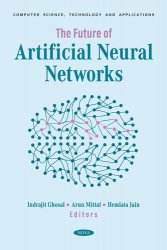The Future of Artificial Neural Networks
- Добавил: literator
- Дата: 19-06-2024, 13:39
- Комментариев: 0
 Название: The Future of Artificial Neural Networks
Название: The Future of Artificial Neural NetworksАвтор: Indrajit Ghosal, Arun Mittal, Hemlata Jain
Издательство: Nova Science Publishers
Серия: Computer Science, Technology and Applications
Год: 2024
Страниц: 222
Язык: английский
Формат: pdf (true)
Размер: 18.0 MB
This book is a compilation of eleven quality articles exploring a variety of aspects on applications of ANN. Various authors of the articles have presented their work around the applications of ANN in healthcare and self-medication behaviour, Stock Market Analytics, ANN integrated application for industries including regulatory complaining aspect in Banking Industry, Deep Learning Framework in Medical Diagnosis, Face Recognition, Mobile Learning in Medical Education, Process and Applications of ANN using MATLAB, etc.
Chapter 1 - This chapter explores the integration of Machine Learning techniques, particularly deep neural networks, in the field of medical image processing for precision medicine. The healthcare industry has accumulated vast amounts of complex data, and advancements in technology have led to an increase in structured and unstructured medical data. The chapter discusses the historical development of image processing techniques, moving from labor-intensive approaches to more efficient and faster operations using artificial neural networks. Various feature extraction methods, with a focus on dimensionality reduction, are investigated to optimize the performance of neural networks. The application of deep neural network models in medical imaging is explored, with a gradual implementation strategy proposed to address challenges related to data variability across institutions.
Chapter 2 - Data that considerably deviates from the mean are called outliers, and they must be identified, has been an important issue in many fields of study and practical use, such as the detection of network intrusions, outbreak recognition, and video surveillance. Streaming data is a large and complex dataset, and Deep Learning-based techniques have recently shown superiority over Machine Learning and shallow approaches for the goal of spotting outliers in this data. It is challenging to create a reliable and appropriate model for outlier identification because of constant change and variations of applications in real life and statistics.
Chapter 3 - This chapter explores the application of Unsupervised Learning in civil engineering, focusing on its advantages and challenges. Unsupervised Learning is a Machine Learning approach that is becoming increasingly popular in the field of civil engineering. This method utilizes the model’s ability to learn from unlabeled datasets and focuses on uncovering structures and patterns within the data. This type of learning offers several benefits for civil engineers. One advantage of unsupervised learning methods is the ability to analyze large amounts of unlabeled data more effectively. Labeling datasets, especially in complex data types such as images or sensor data, can be a tedious and time-consuming task. Unsupervised learning provides a more efficient alternative to overcome this challenge.
...
Chapter 9 - In our daily lives, the human face is crucial, particularly for identifying people. Face recognition is a sort of identification via biometrics in which facial features are extracted from a person’s face and saved as a unique face print. This unique face print is used to identify a person. Due to its non-contact process, face recognition technology is superior to finger, palm, and iris prints can be used as biometric identification methods. Artificial Neural Networks (ANNs) play a crucial role in face recognition systems by providing the underlying architecture for the machine learning algorithms used in the process. Here in this project, the authors used Convolutional Neural Networks (CNNs) advance version of ANN. This study suggested using the Python Library to create a real-time face detection and recognition attendance system. Main library which the authors used is OpenCV and face_recognition library.
Chapter 10 - The most crucial tasks in the banking system are the shared and collected papers related to regulatory complaints that are routinely audited. The introduction of technology has been a suitable move, as it can bridge the gap in financial services. Digital completion platforms primarily focus on building client relationships and helping customers resolve their banking problems effectively. The steps that must be taken to escalate this matter are more complicated and intricate, and there are no returns. Customers become frustrated and lose faith in the system. The electronic market and banking sector, which can interchange clearinghouses and other trading facilities, form the foundation of the financial fintech system.
Скачать The Future of Artificial Neural Networks
Внимание
Уважаемый посетитель, Вы зашли на сайт как незарегистрированный пользователь.
Мы рекомендуем Вам зарегистрироваться либо войти на сайт под своим именем.
Уважаемый посетитель, Вы зашли на сайт как незарегистрированный пользователь.
Мы рекомендуем Вам зарегистрироваться либо войти на сайт под своим именем.
Информация
Посетители, находящиеся в группе Гости, не могут оставлять комментарии к данной публикации.
Посетители, находящиеся в группе Гости, не могут оставлять комментарии к данной публикации.
